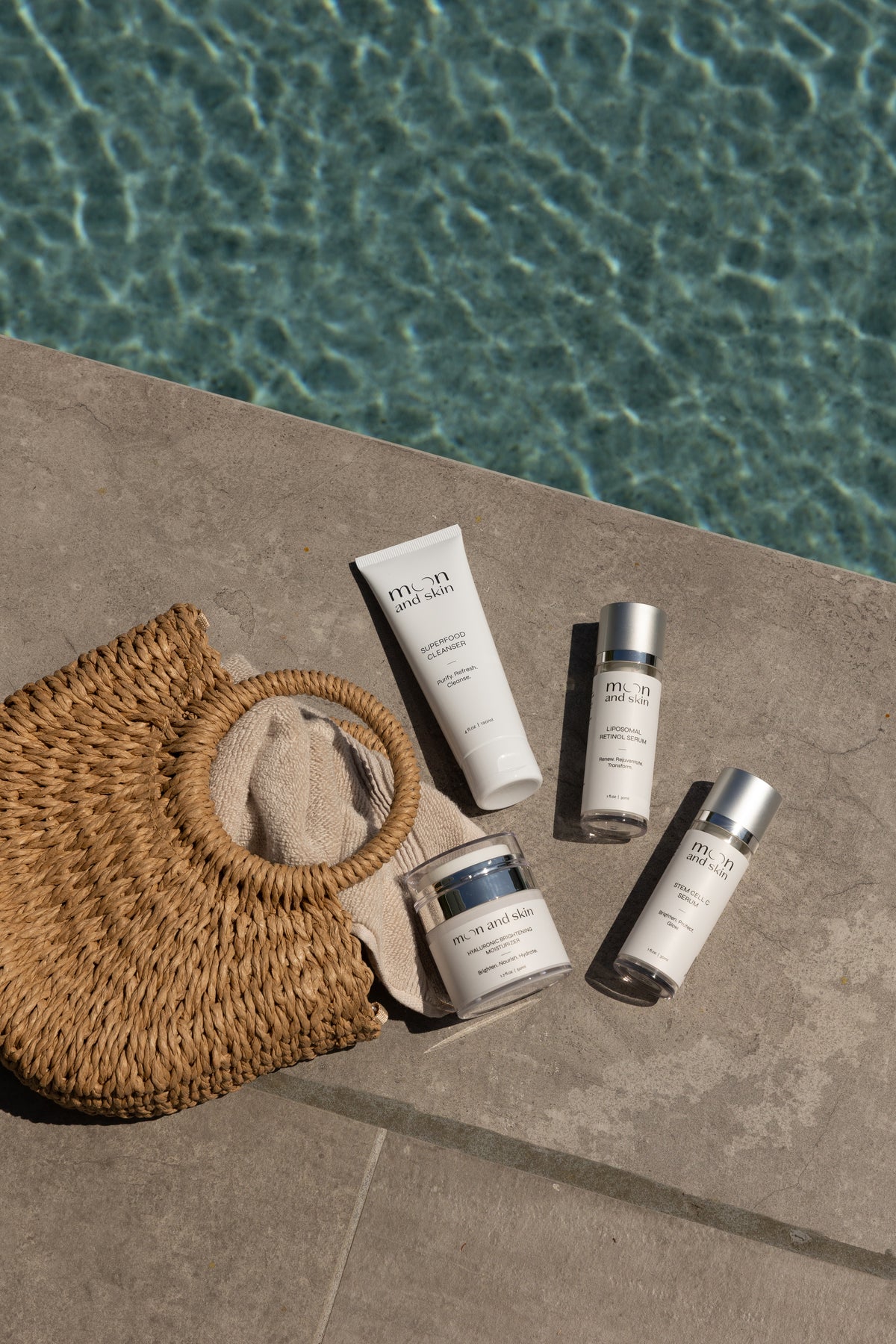Table of Contents
Introduction
In the realm of skincare, oils have garnered attention for their myriad benefits. With the rise of clean beauty and a growing awareness of natural ingredients, rosehip oil and castor oil have emerged as two popular choices. Both oils offer unique advantages, but how do you decide which one is best for your skin?
We understand that navigating the world of oils can be overwhelming, especially with the conflicting information available. This blog post aims to clarify the distinctions between rosehip oil and castor oil, exploring their origins, nutritional profiles, benefits, and ideal usage. By the end, you'll have a clearer understanding of which oil may best suit your skincare needs and how to incorporate it into your routine effectively.
Let's embark on this journey together and uncover the properties that make rosehip oil and castor oil stand out in the world of natural skincare.
The Origins of Rosehip Oil and Castor Oil
Rosehip Oil: A Natural Treasure
Rosehip oil is derived from the seeds of the Rosa canina, commonly known as the wild rose. The cold-press extraction method preserves its rich nutrient profile, making it a sought-after ingredient in skincare formulations. Historically, rosehip oil has been used for centuries, particularly in South America and Europe, where its skin healing properties have been valued.
Castor Oil: The Ancient Remedy
Castor oil, extracted from the seeds of the Ricinus communis plant, has a history that dates back to ancient Egypt. It was revered not only for its skin benefits but also for its versatility in medicinal applications. Today, castor oil is celebrated for its moisturizing properties and its use in hair care, making it a multi-functional ingredient in both skincare and beauty products.
Composition and Nutritional Profile
Nutrients in Rosehip Oil
Rosehip oil is a powerhouse of essential fatty acids, particularly linoleic acid (omega-6) and alpha-linolenic acid (omega-3). It also boasts a high concentration of vitamins A, C, and E, which are crucial for skin regeneration and protection against environmental damage. The antioxidants present in rosehip oil help combat oxidative stress and promote a youthful appearance.
Nutrients in Castor Oil
While castor oil may not have as diverse a nutrient profile as rosehip oil, it is rich in ricinoleic acid—a unique fatty acid known for its anti-inflammatory and antibacterial properties. Castor oil also contains vitamin E and various minerals that contribute to its skin-nourishing qualities. Its thick consistency acts as an occlusive agent, locking in moisture and providing a protective barrier on the skin.
Benefits of Rosehip Oil
Skin Regeneration and Healing
One of the most celebrated benefits of rosehip oil is its ability to promote skin regeneration. The high levels of vitamin A (in the form of retinoids) make it effective in reducing the appearance of scars, fine lines, and hyperpigmentation. Regular use can lead to improved skin texture and tone.
Hydration and Moisture Retention
Rosehip oil is not only nourishing but also hydrating. Its lightweight texture allows for quick absorption, making it suitable for various skin types, including oily and acne-prone skin. The essential fatty acids in rosehip oil help maintain the skin's moisture balance without leaving a greasy residue.
Anti-Inflammatory Properties
The anti-inflammatory properties of rosehip oil make it a great ally for those with sensitive or irritated skin. It can soothe redness and irritation, making it suitable for conditions such as rosacea and eczema. Regular use can lead to a calmer and more balanced complexion.
Antioxidant Protection
The antioxidants present in rosehip oil help protect the skin from free radical damage, which can accelerate aging and lead to various skin concerns. By neutralizing these harmful compounds, rosehip oil contributes to a healthier, more resilient skin barrier.
Benefits of Castor Oil
Deep Moisturization
Castor oil's thick, viscous nature makes it an exceptional moisturizer, particularly for dry or dehydrated skin. It creates a barrier that locks in moisture, preventing transepidermal water loss. This is especially beneficial for individuals living in dry climates or during harsh weather conditions.
Anti-Acne Properties
Despite its thickness, castor oil possesses anti-inflammatory and antibacterial properties that can help combat acne. It can reduce redness and swelling associated with breakouts, making it a potential option for those struggling with acne-prone skin. However, caution is advised, as its heavy texture may not be suitable for all skin types.
Hair and Eyelash Benefits
Beyond skincare, castor oil is widely used for hair and eyelash care. Its nourishing properties can promote healthy hair growth and thickness. Many individuals apply castor oil to their eyelashes and eyebrows to enhance their appearance and stimulate growth.
Healing Scars and Stretch Marks
Castor oil is often recommended for reducing the appearance of scars and stretch marks. Its ability to penetrate deeply into the skin and promote healing can help fade these marks over time. Regular application may yield noticeable improvements in skin texture.
How to Use Rosehip Oil and Castor Oil
Incorporating Rosehip Oil into Your Routine
To maximize the benefits of rosehip oil, follow these steps:
- Cleanser: Start with a gentle cleanser to remove impurities from your skin.
- Toner: Apply a hydrating toner to prep your skin for better absorption.
- Rosehip Oil Application: Dispense a few drops of rosehip oil into your palms and gently press it onto your face and neck. This can be done both morning and night.
- Moisturizer: Follow up with a moisturizer to seal in hydration and maximize the benefits of the oil.
Incorporating Castor Oil into Your Routine
Due to its thickness, castor oil is often best used in combination with a lighter oil:
- Cleansing: Use a mild cleanser to ensure your skin is clean.
- Dilution: Mix a small amount of castor oil with your chosen lighter oil (such as jojoba or argan oil).
- Targeted Application: Apply the mixture to areas of concern, such as dry patches, scars, or acne-prone areas. Avoid using it as an all-over moisturizer if you have oily skin.
- Hair Treatment: For hair benefits, apply the oil mixture to your scalp and hair, leave it on for a few hours or overnight, then wash it out.
Choosing Between Rosehip Oil and Castor Oil
When deciding between rosehip oil and castor oil, consider your specific skin needs and goals:
- For Healing and Regeneration: If you're looking to improve skin texture, reduce scars, or enhance overall radiance, rosehip oil is an excellent choice.
- For Deep Moisturization: If your primary concern is intense hydration or you are dealing with dry skin, castor oil may be the better option.
- For Acne-Prone Skin: Rosehip oil may be more suitable for oily or acne-prone skin due to its lightweight nature and regenerative properties, while castor oil should be used cautiously.
- For Hair and Lash Care: If you're interested in promoting hair or eyelash growth, castor oil is a tried-and-true remedy.
Conclusion
In the battle of rosehip oil vs castor oil, both oils shine in their unique ways. While rosehip oil excels in its regenerative and brightening properties, castor oil offers deep moisturization and protective qualities. Ultimately, the choice between these oils comes down to your individual skin type, concerns, and preferences.
As you explore the world of natural skincare, we invite you to join the Moon and Skin community. Our mission is to provide clean and thoughtful skincare for every phase of life, supporting your skin journey with high-quality products. Consider trying our Stem Cell C Serum for its brightening and hydrating benefits, or explore our Bundle & Save collection to build a complete skincare routine that works for you.
FAQ
- Can I use rosehip oil and castor oil together? Yes, you can use both oils together. For best results, consider mixing rosehip oil with castor oil to enjoy the benefits of both—rosehip for regeneration and castor for deep hydration.
- Will rosehip oil clog my pores? Rosehip oil is generally non-comedogenic, meaning it is unlikely to clog pores. However, individual reactions may vary, so it’s always a good idea to patch test before full application.
- Can castor oil cause breakouts? Due to its thick consistency, castor oil can potentially clog pores for some individuals, especially those with oily or acne-prone skin. Consider using it in moderation or mixing it with lighter oils.
- How often should I use rosehip oil? You can use rosehip oil daily, both in the morning and evening, as part of your skincare routine. Its lightweight nature makes it suitable for frequent use.
- Is castor oil safe for sensitive skin? Castor oil can be beneficial for sensitive skin due to its anti-inflammatory properties, but it’s essential to conduct a patch test first to ensure no adverse reactions occur.
By understanding the unique benefits of rosehip oil and castor oil, you can make informed choices that align with your skincare journey. Embrace the power of nature and nurture your skin with these incredible oils!







